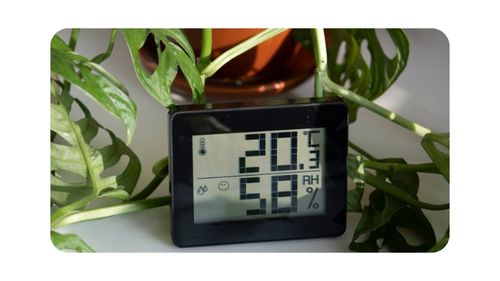Solid wood acoustic guitars can be fairly delicate instruments that can crack due to changes in humidity. Even local climates that experience long periods of dry heat, can impact the sound quality of an acoustic guitar.
Related Post: Why Do Old Solid Wood Acoustic Guitars Sound Better With Age?
You see, guitars made from natural solid wood can become dried out by heat/humidity cycles, ultimately resulting in splintering. But, this won’t happen if that guitar is carefully kept in a low-humidity space.
Yet, can the same be said for laminated guitars too?
Well, in this post you’ll learn exactly why humidity can ruin the sound quality of acoustic guitars. You’ll also learn why laminate guitars may need a guitar humidifier — and what will happen if you don’t use one.
And keep reading to discover what a digital hygrometer is and why it’s key to preventing your guitar from cracking…

This post may contain affiliate links to products that we receive a commission for (at no additional cost to you). Learn more here.
Aren’t Laminate Guitars More Crack Resistant Than Solid Wood Guitars?
For the most part, they are.
You see, all-laminate guitars are made up of multiple layers of wood (or other materials). And each layer helps to reinforce one another.
That added reinforcement makes an all-laminate guitar more robust than a natural solid wood one.
However, there are partially laminated guitars known as Laminate Tops. These part-laminate guitars have laminated backs and sides. But, the tops of these guitar are natural solid wood.
These guitars, once again, can be stronger than ones that are wholly solid wood. Nevertheless, they aren’t quite as durable as all-laminate ones.
OK. And Do Laminate Guitars Get Better Over Time With Age?
Laminate top acoustic guitars certainly do.
As the solid wood tops of these guitars age and dry out, they become harder and stronger. And this, in turn, increases the tensile strength of that natural solid wood.
This increased strength is what leads to an improvement in the sustain of the instrument, enhancing sound quality.
However, the change in sound quality is more noticeable in aging solid wood acoustic guitar — and laminate top guitars. Yet, there is little to no noticeable difference in sound quality (over time) with aging all-laminate guitars.
Regardless, a solid wood (or laminated top) guitar — that slowly dries out over the years — can lead to improvements in sound quality.
Related Post: Is It True? Do Laminate Guitars Improve With Age?
If That’s The Case, Then Why Are Guitar Humidifiers Necessary?
An acoustic guitar, that slowly dries out over many years, isn’t a problem. However, if a guitar dries out too quickly, this can cause issues.
If you live in a very humid area, then that humidity can damage even all-laminate guitars. Especially laminate guitars made using wooden layers.
Humid air is filled with moisture. And that moisture can saturate the wood of a guitar. When that happens, wood shifts and expands.
Now, the real issues start when that wood begins to dry out afterwards — often too fast.
As wood dries, it contracts and shrinks. And if it does this much too quickly, it will crack and split.
So, the reason we use a humidifier is to help prevent your guitar from drying out too fast (or at all).
Do I Really Need A Humidifier For My Guitar? What Happens If I Don’t Humidify My Guitar?
A humidity-saturated guitar (if it is allowed to dry out) will shrink too much too fast. So much so, that it will crack.
And those cracks and splits can cause a whole roster of problems.
If there are too many splits, this can reduce the sustain of your guitar. Worse still, cracks can cause frets to begin to shift out of place.
Having said that, using a guitar humidifier is only something you need if you happen to live in a hot humid area. Or if you live in a climate that has very dry heat.
If you live in a more moderate climate, then a guitar humidifier may not be something you’ll ever need.
But Do I Need To Worry About Humidifiers Causing Any Damage To My Acoustic Guitars?
Unless you decide to throw them directly at your guitar, you don’t need to worry about them damaging your instrument.
Guitar humidifiers — even soundhole humidifiers — aren’t actually attached to the body of your guitar. They are propped up by the strings instead.
Even home made soap dish humidifiers are placed nearby, (but not actually on), your instrument. So neither setup will cause damage to your instrument.
Related Post: Is Pine Wood A Good Choice For DIY Guitars?
And What’s The Best Guitar Humidifier You Can Buy?
D’Addario Accessories has an incredibly easy-to-use guitar humidifier. This gizmo has a similar setup to a homemade humidifier (i.e. a soap dish with a sponge in it).
Yet what makes D’Addario Accessories soundhole humidifier unique is its non-drip design. The design allows this soundhole humidifier to purposefully slow-release moisture into the air.
This little affordable humidifier makes it easy to maintain ideal 45-55% RH (relative humidity) levels around your guitar.
And How Exactly Do You Measure Relative Humidity Levels?
You will need something called a Digital Hygrometer. These devices let you monitor the level of humidity in any given space or area.

AcuRite has a compact digital hygrometer that measures not only humidity but also temperature in both Fahrenheit or Celsius.
And it can measure relative humidity levels between 21% RH to 80% RH (within 3% +/- accuracy).
To Wrap Up, Here Are The 3 Key Takeaways From This Post…
- 1). Guitar humidifiers are designed to help prevent the wooden material of a guitar from drying out too quickly.
- 2). If your laminate guitar is made from wooden layers, (or has a solid wood top), then it can benefit from the use of a guitar humidifier.
- 3). Guitar humidifiers are useful to have if you store your guitars in very humid areas. Or in environments that experience constant dry-heat.



